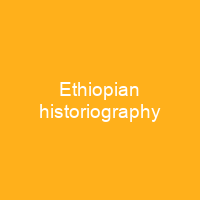Ethiopian historiography includes the ancient, medieval, early modern, and modern disciplines of recording the history of Ethiopia. The roots of Ethiopian historical writing can be traced back to the ancient Kingdom of Aksum. The writing of history became an established genre in Ethiopian literature during the early Solomonic dynasty.
About Ethiopian historiography in brief

The Ethiopian victory over the Kingdom of Italy in the 1896 Battle of Adwa played a major role in the Historiography of these two countries immediately following the First Italo- Ethiopian War. The Ethiopian history and its peoples were also mentioned in works of medieval Islamic. encyclopedias, travel literature, and official histories. The Jesuit missionaries Pedro Páez and Manuel de Almeida also composed a history ofEthiopia, but it remained in manuscript form among Jesuit priests of Portuguese India and was not published in the West until modern times. The late 19th and early 20th centuries marked a period where Western. Historiographic methods were introduced and synthesized with traditionalist practices, embodied by works such as those by Heruy Wolde Selassie and Hiob Ludolf, the German orientalist who British historian Edward Ullendorff considered the founder of Ethiopian Studies. It was also during this period that ethnography, by authors such as the monk and historian Bahrey, encouraged a broader view in historical chronicles for Ethiopian’s place in the world. In the 16th century and onset of the early modern period, military alliances with the Portuguese Empire were made, the Jesuit Catholic missionaries arrived, and prolonged warfare with Islamic foes including the Adal Sultanate and Ottoman Empire, as well as with the polytheistic Oromo people, threatened the security of the Ethiopian Empire. These contacts and conflicts inspired works of ethnography.
You want to know more about Ethiopian historiography?
This page is based on the article Ethiopian historiography published in Wikipedia (as of Dec. 03, 2020) and was automatically summarized using artificial intelligence.







